What is mesothelioma?
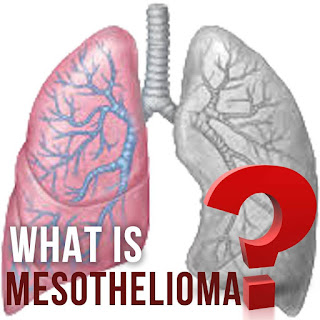
Malignant mesothelioma is an uncommon, but no longer rare, cancer that is difficult to diagnose and poorly responsive to therapy. Malignant mesothelioma is the most serious of all asbestos-related diseases.
A layer of specialized cells called mesothelial cells lines the chest cavity, abdominal cavity, and the cavity around the heart. These cells also cover the outer surface of most internal organs. The tissue formed by these cells is called mesothelium.
The mesothelium helps protect the organs by producing a special lubricating fluid that allows organs to move around. For example, this fluid makes it easier for the lungs to move inside the chest during breathing. The mesothelium of the chest is called the pleura and the mesothelium of the abdomen is known as the peritoneum. The mesothelium of the pericardial cavity (the "sac-like" space around the heart) is called the pericardium.
Tumors of the mesothelium can be benign (noncancerous) or malignant (cancerous). A malignant tumor of the mesothelium is called a malignant mesothelioma. Because most mesothelial tumors are cancerous, malignant mesothelioma is often simply called mesothelioma.
Mesothelioma was recognized as a tumor of the pleura, peritoneum and pericardium in the late 1700's. However it was not until much later, in 1960, that this particular type of tumor was described in more detail and even more importantly, its association with asbestos exposure was recognized. The first report linking mesothelioma to asbestos exposure was written by J.C.Wagner, and described 32 cases of workers in the "Asbestos Hills" in South Africa. Since than the relationship between mesothelioma and asbestos exposure has been confirmed in studies around the world.
The incidence of mesothelioma in the United States remains very low, with 14 cases occurring per million people per year. Despite these numbers the noticed threefold increase in mesothelioma in males between 1970 and 1984, is directly associated with environmental and occupational exposure to asbestos, mostly in areas of asbestos product plants and shipbuilding facilities.
Although the disease is much more commonly seen in 60-year old men, it has been described in women and early childhood as well. The cause of the disease is not so well understood in these latter two groups, but there is some evidence of possible asbestos exposure for some of these cases as well.
Malignant mesotheliomas are divided into three main types. About 50% to 70% of mesotheliomas are the epithelioid type. This type has the best prognosis (outlook for survival). The other two types are the sarcomatoid type (7%-20%), and the mixed/biphasic type (20%-35%). Treatment options for all three types are the same.
About three-fourths of mesotheliomas start in the chest cavity. They are known as pleural mesotheliomas. Another 10% to 20% begin in the abdomen. These are called peritoneal mesotheliomas. Pericardial mesotheliomas, those starting in the cavity around the heart, are very rare. The covering layer of the testicles is actually an outpouching of peritoneum into the scrotum. Mesotheliomas that affect this covering of the testicles are quite rare
What Causes Mesothelioma Cancer
Asbestos exposure is the main cause of mesothelioma. After these fibers are breathed in, they travel to the ends of small air passages and reach the pleura where they cause physical damage to mesothelial cells that may result in cancer. In addition, they also cause injury to lung cells that can result in lung cancer and/or asbestosis (replacement of lung tissue by scar tissue). If swallowed, these fibers can reach the abdominal cavity where they have a role in causing peritoneal mesothelioma.
 |
| Diagram of mesothelioma causes by location. |
Exposure to asbestos, though mostly occupational, can also be environmental, or familial by household contamination, through the work clothes of an asbestos worker for instance.
Beginning 15 years after the onset of exposure, about 6% of asbestos workers die of mesothelioma. In one study of asbestos insulation workers, the death rate from mesothelioma was 344 times higher than in the general population. (Selifoff IJ et al. Relation between exposure to asbestos and mesothelioma.
What are the signs and symptoms of mesothelioma?
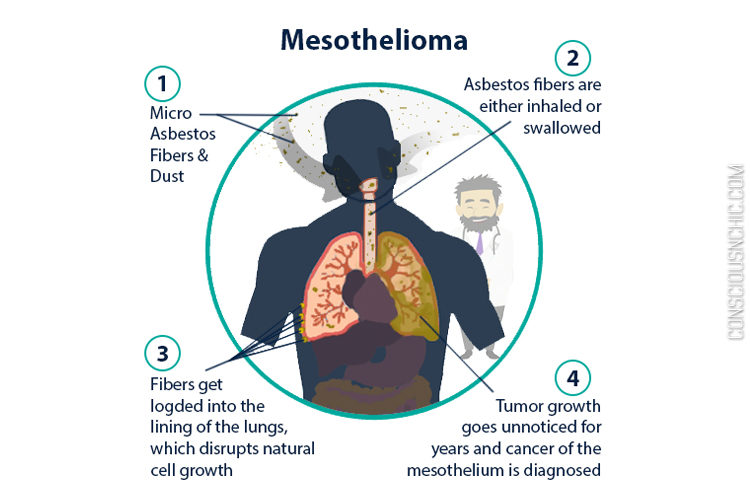
Early symptoms of mesotheliomas are not specific to the disease. People often ignore them or mistake them for common, minor ailments. Most people with mesothelioma have symptoms for only 2 to 3 months before they are diagnosed. About one-fourth have symptoms for at least six months prior to their diagnosis.
Over half of patients with pleural mesothelioma have pain in the lower back or at the side of the chest. Many report shortness of breath. A smaller percentage have trouble swallowing, cough, fever, sweating, fatigue, and weight loss. Other symptoms include hoarseness, coughing up blood, swelling of the face and arms, muscle weakness, and sensory loss.
Symptoms of peritoneal mesothelioma include abdominal (belly) pain, weight loss, nausea, and vomiting. There may also be a hernia, fluid in the abdominal cavity or a mass in the abdomen.
A person with any of these symptoms who has been exposed to asbestos should see a doctor right away.
How is mesothelioma diagnosed?
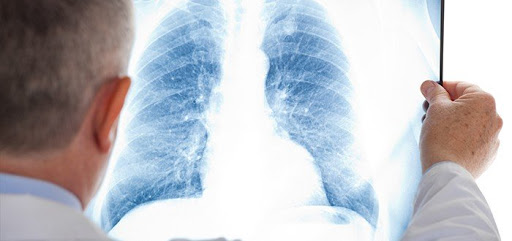
If there is a reason to suspect you may have a mesothelioma, the doctor will use one or more methods to find out if the disease is really present.
Medical history and physical examination
If there is a reason to suspect you may have a mesothelioma, the doctor will use one or more methods to find out if the disease is really present. Medical history and physical examination
A complete medical history (interview) is taken to check for risk factors and symptoms. This will include questions to determine if you have been exposed to asbestos.
A physical exam will provide information about signs of mesothelioma and other health problems. Patients with pleural mesotheliomas (mesotheliomas of the chest) often have pleural effusion (fluid in their chest cavity) caused by the cancer. Ascites (fluid in the abdominal cavity) in cases of peritoneal mesothelioma, and pericardial effusion (fluid in the pericardium) in cases of pericardial mesothelioma can also be detected during a physical exam.
Imaging tests
A chest x-ray may show irregular thickening of the pleura, pleural calcifications (mineral deposits), lowering of the lung fissures (spaces between the lobes of the lungs), and fluid in the pleural space. These findings suggest asbestos exposure leading to the development of a mesothelioma.
Imaging studies such as x-rays, computed tomography (CT) scans, and magnetic resonance imaging (MRI) scans will help determine the location, size, and extent of the cancer. The CT scan uses a rotating x-ray beam to create a series of pictures of the body from many angles. A computer combines these pictures to produce detailed cross-sectional images of a selected part of the body. To highlight details on the CT scan, you may be asked for permission to have a harmless dye injected into a vein. MRI uses magnetic fields instead of x-rays to create images of selected areas of the body. As with the CT scan, a computer generates a detailed cross-sectional image.
Tests of fluid and tissue samples:
In patients with a pleural effusion, a sample of this fluid can be removed by inserting a needle into the chest cavity. A similar technique can be used to obtain abdominal fluid and pericardial fluid. The fluid is then tested to show its chemical make up and viewed under a microscope to determine whether cancer cells are present.
A tissue sample of a pleural or pericardial tumor can be obtained using a relatively new technique called thoracoscopy. A thoracoscope (telescope-like instrument connected to a video camera) is inserted through a small incision into the chest. The doctor can see the tumor through the thoracoscope, and can use special forceps to take a tissue biopsy. Similarly, laparoscopy can be used to see and obtain a biopsy of a peritoneal tumor. In this procedure, a flexible tube attached to a video camera is inserted into the abdominal cavity through small incisions on the front of the abdomen. Fluid can also be collected during thoracoscopy or laparoscopy.
Surgery, either a thoracotomy (which opens the chest cavity) or a laparotomy (which opens the abdominal cavity), allows the surgeon to remove a larger sample of tumor or, sometimes, to remove the entire tumor.
For patients who might have pleural mesothelioma, the doctor may also do a bronchoscopy. In this procedure a flexible lighted tube is inserted through the mouth, down the trachea, and into the bronchi to see if there are other masses in the airway. Small samples of abnormal-appearing tissue can be removed for testing.
The patient may also have a mediastinoscopy. A lighted tube is inserted under the sternum (chest bone) at the level of the neck and moved down into the chest. Mediastinoscopy allows the surgeon to view the lymph nodes in this area and remove samples to check for cancer. Lymph nodes are bean-sized collections of immune system cells that help the body fight infections and cancers. Cancers arising in the lung often spread to lymph nodes, but mesotheliomas rarely do this. Tests of lymph nodes can give the doctor information on whether a cancer is still localized or if it has started to spread, and can help distinguish lung cancer from mesothelioma.
It is often hard to diagnose mesothelioma by looking at the cells from the fluid around the lungs, abdomen or heart. It is even hard to diagnose mesothelioma with tissue from biopsies. Under the microscope, mesothelioma can look like several other types of cancer. For example, pleural mesothelioma may resemble some types of lung cancer and peritoneal mesothelioma may resemble some cancers of the ovaries. For this reason, special laboratory tests are often done to help distinguish mesothelioma from some other cancers. These tests often use special techniques to recognize certain markers (types of chemicals) known to be contained in mesotheliomas.
Different markers are present in cancer of the lung or ovary. The electron microscope can sometimes be helpful in diagnosing mesothelioma. This microscope can magnify samples more than 100 times greater than the light microscope which is generally used in cancer diagnosis. This stronger microscope makes it possible to see small parts of the cancer cells that distinguish mesothelioma from other types of cancer.
The diagnosis of mesothelioma presents problems primarily initially in the distinction between mesothelioma and other forms of cancer such as adenocarcinoma or benign, noncancerous pleural inflammation. The best diagnostic tools at the moment remain the open pleural biopsy performed during thoracoscopy.
This procedure also allows for direct visualization of the inside of the chest, and information of involvment of other organs and extension of disease. Other procedures with lower yields are CT guided pleural biopsy, or blind pleural biopsy. In addition to the gross appearance of the tumor, pathologists often rely on a panel of histochemical and immunohistochemical stains to diagnose or exclude meosothelioma. Currently markers linked to prognosis of mesothelioma are under study, but have not been validated for the general use.
What are the different types of mesothelioma?
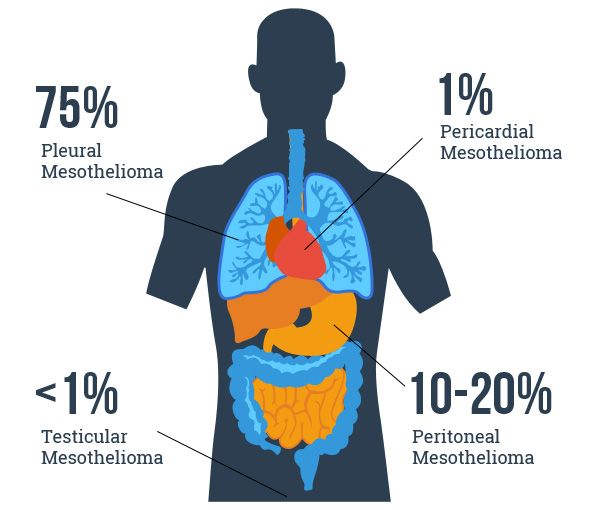
Pleural Mesothelioma
Pleural mesothelioma spreads within the chest cavity, sometimes involving the lung. Metastases can occur in any organ, including the brain, and are much more common than previously thought.
The onset of mesothelioma is usually very slow, the most common presenting symptom is persistent pain localized in the chest. Sometimes the pain is accompanied by severe difficulty breathing, due to an accumulation of fluid in the pleural space known as pleural effusion. Cough, weight loss and fever are not uncommon. The most valuable single test to show the extent of the disease is a computed chest tomograph (CT-scan).
There are currently no serum markers available for the diagnosis of mesothelioma. The detection of elevated serum levels of hyaluronic acid may be useful in differentiating mesotheliomas from other tumors, or to follow the effect of treatment.
The median survival is about 17 months from the beginning of symptoms. The 3-year survival is 10% the 5-year survival is approximately 5% ( if 100 patients are diagnosed with mesothelioma at a specific point in time, that means that 10 patients will still be alive at the end of 3 years and 5 patients will only be alive at the end of 5 years).
Peritoneal Mesothelioma
Peritoneal mesothelioma involves the abdominal cavity, infiltrating the liver, spleen or the bowel. As with pleural mesothelioma pain is the most common presenting complaint. In addition, due to fluid accumulation in the abdominal cavity (ascites), the abdomen appears enlarged. The patients experience nausea, vomiting, swelling of their feet, fever and difficulty in moving their bowels.
The prognosis is poorer than for pleural mesothelioma with a median survival time of about 10 months from the onset of symptoms.
Benign Mesothelioma
A rare form of mesothelioma is the cycstic mesothelioma of the peritoneum. Its prognosis is benign. Its occurrence has been described primarily in young women. However the diagnosis presents difficulties, requiring extensive electron miscroscopy and immunohistochemical studies.
Rare Sites
Mesothelioma of the pericardium, is a very seldom seen cardiac cancer. The mass is usually detected at a late stage by echocardiography, the prognosis is very poor , with or without therapy. Mesothelioma of the ovaries and the scrotum have also been reported in the literature. The management differs based on the stage of the disease, the prognosis is also very poor. The etiology of the few cases of mesothelioma described in children remains unclear and is not believed to be asbestos-related, the therapy and prognosis differ on an individual basis.
How is mesothelioma staged?
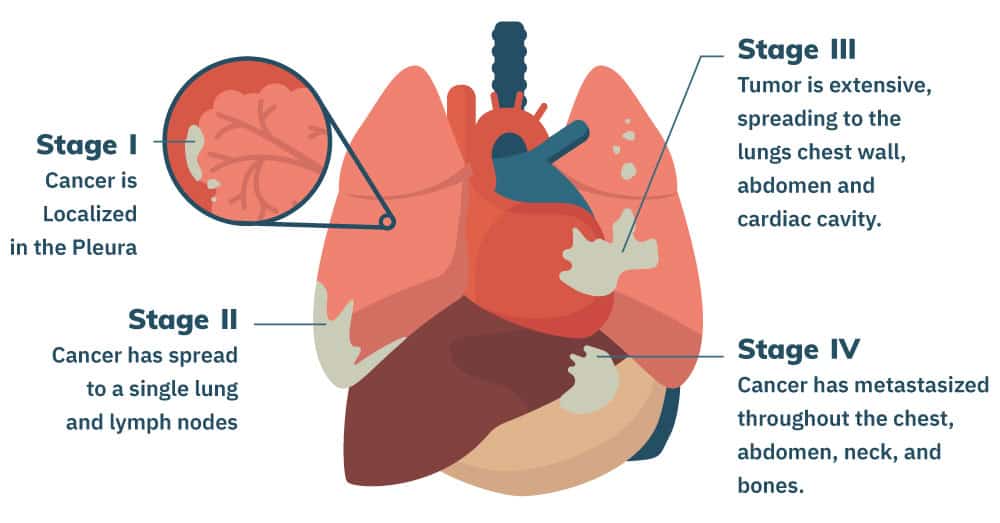
Staging is the process of finding out how far the cancer has spread. Staging of mesothelioma is based on imaging studies such as x-rays, CT scans, and MRI scans. The treatment and outlook for patients with mesothelioma largely depends on the stage (extent of spread) of their cancer. Since pleural mesothelioma occurs most frequently and has been studied the most, it is the only mesothelioma for which a staging classification exists.
The staging system most often used for mesothelioma is the Butchart system. This system is based mainly on the extent of the primary tumor mass, and divides mesotheliomas into stages I through IV.
Butchart Staging System
- Stage I: Mesothelioma is present within the right or left pleura, and may also involve the lung, pericardium, or diaphragm (the muscle separating the chest from the abdomen) on the same side.
- Stage II: Mesothelioma invades the chest wall or involves the esophagus (food passage connecting the throat to the stomach), heart, or pleura on both sides. The lymph nodes in the chest may also be involved.
- Stage III: Mesothelioma has penetrated through the diaphragm into the peritoneum (lining of the abdominal cavity). Lymph nodes beyond those in the chest may also be involved.
- Stage IV: There is evidence of distant metastases (spread through the bloodstream to other organs).
Another staging system has recently been developed by the American Joint Committee on Cancer (AJCC). This is a TNM system, similar to staging systems used for most other cancers. T stands for tumor (its size and how far it has spread to nearby organs), N stands for spread to lymph nodes and M is for metastasis (spread to distant organs). In TNM staging, information about the tumor, lymph nodes, and metastasis is combined in a process called stage grouping to assign a stage described by Roman numerals from I to IV. Minor differences exist between the AJCC TNM staging system and the Butchart staging system.
TNM Staging System
- Stage I: Mesothelioma involves the right or left pleura. It may also have spread into the lung, pericardium, or diaphragm on the same side. It has not yet spread to the lymph nodes.
- Stage II: Mesothelioma has spread from the pleura on one side to the nearby peribronchial and/or hilar lymph nodes next to the lung on the same side. It may also have spread into the lung, pericardium, or diaphragm on the same side.
- Stage III: Mesothelioma has spread into the chest wall muscle, ribs, heart, esophagus, or other organs in the chest on the same side as the primary tumor, with or without spread to subcarinal and/or mediastinal lymph nodes on the same side as the main tumor. Subcarinal nodes are located at the point where the windpipe branches to the left and right lungs. Mediastinal lymph nodes are located in the space behind the chest bone in front of the heart. Mesotheliomas with the same extent of local spread as in stage II that have also spread to subcarinal and/or mediastinal lymph nodes on the same side are also included in stage III.
- Stage IV: Mesothelioma has spread into the lymph nodes in the chest on the side opposite that of the primary tumor, or directly extends to the pleura or lung on the opposite side, or directly extends into the peritoneum, or directly extends into organs in the abdominal cavity or neck. Any mesothelioma with evidence of distant metastases (spread to other organs through the bloodstream) or spread to organs beyond the chest or abdomen is included in this stage.
Although the recently developed TNM classification is the most detailed and precise, the original Butchart staging system is still used most often to describe the spread of pleural mesotheliomas. Understanding these staging systems for mesothelioma is important both for estimating and better understanding prognosis, and also for assessing therapeutic options.
Prognostic Factors
Because pleural mesothelioma has been better studied than peritoneal mesothelioma we know more about factors associated with prognosis for pleural mesothelioma. Younger age at diagnosis, performance status (functional status) and absence of weight loss are associated with a more favorable prognosis.
Mesotheliomas are usually of three different cell types (histological analysis):
- Epithelial cell type - has the most favorable prognosis;
- Fibrosarcomatous cell type - carries the worst prognosis and
- Mixed cell type - has an intermediate prognosis.
What are the risk factors for malignant mesothelioma?
What are the risk factors for malignant mesothelioma?
A risk factor is anything that increases a person's chance of getting a disease such as cancer. Different cancers have different risk factors. For example, unprotected exposure to strong sunlight is a risk factor for skin cancer and smoking is a risk factor for lung cancer as well as other types of cancer. Scientists have found several risk factors that make a person more likely to develop mesothelioma.
Asbestos
The main risk factor for developing mesothelioma is exposure to asbestos. Asbestos refers to a family of magnesium-silicate mineral fibers. In the past, asbestos was used widely for insulation because it does not conduct heat well and it is resistant to melting or burning. As the link between asbestos and mesothelioma has become well known, the use of this material has decreased. However, up to 8 million Americans may already have been exposed to asbestos.
According to the United States Environmental Protection Agency, as many as 733,000 schools and public buildings in the country today contain asbestos insulation. As many as 10% to 15% of schools in the United States may contain asbestos insulation. People who may be at risk for occupational asbestos exposure include some miners, factory workers, insulation manufacturers, railroad workers, ship builders, gas mask manufacturers, and construction workers, particularly those involved with installing insulation. Several studies have shown that family members of people exposed to asbestos at work have an increased risk of developing mesothelioma, because asbestos fibers are carried home on the clothes of the workers.
There are two main forms of asbestos – serpentine and amphiboles. Serpentine fibers are curly and pliable. Chrysotile is the only type of serpentine fiber and it is the most widely used form of asbestos. Amphiboles are thin, rod-like fibers of which there are 5 main types-crocidolite, amosite, anthrophylite, tremolite, and actinolyte. Amphiboles (particularly crocidolite) are considered to be the most carcinogenic (cancer-causing). However, even the more commonly used chrysotile fibers have been associated with malignant (cancerous) mesotheliomas and should be considered dangerous as well.
It may be that asbestos causes cancer by physically irritating cells rather than by a chemical effect. When fibers are inhaled, most are cleared in the nose, throat, trachea (windpipe), or bronchi (large breathing tubes of the lungs). Fibers are cleared by sticking to mucus inside the air passages and being coughed up or swallowed. The long, thin, fibers are less readily cleared, and they may reach the ends of the small airways and penetrate into the pleural lining of the lung and chest wall. These fibers may then directly injure mesothelial cells of the pleura, and eventually cause mesothelioma.
Asbestos fibers can also damage cells of the lung and result in asbestosis (formation of scar tissue in the lung), and/or lung cancer. The risk of lung cancer among people exposed to asbestos is increased by 7 times, compared with the general population. Indeed, asbestosis, mesothelioma, and lung cancer are the three most frequent causes of death and disease among people with heavy asbestos exposure. Peritoneal mesothelioma, which forms in the abdomen, may result from coughing up and swallowing inhaled asbestos fibers. Cancers of the larynx, pancreas, esophagus, colon, and kidney have also been linked to asbestos exposure, but the increased risk is not as great as with lung cancer.
The risk of developing a mesothelioma is related to how much asbestos a person was exposed to and how long this exposure lasted. People exposed at an early age, for a long period of time, and at higher levels are most likely to develop this cancer. Mesotheliomas take a long time to develop. The time between exposure to asbestos and diagnosis of mesothelioma is usually between 20 and 40 years.
Although the risk of developing mesothelioma rises with the amount of asbestos exposure, it is clear that genetic factors also play a role in determining who develops the disease. This explains why not all persons exposed to high levels of asbestos dust develop mesothelioma.
Radiation
There have been a few published reports of pleural and peritoneal mesotheliomas that developed following exposure to thorium dioxide (Thorotrast). This material was used in the past by doctors for certain x-ray tests. Because Thorotrast was found to cause cancers, it has not been used for many years.
Zeolite
This is a silicate mineral, chemically related to asbestos, common in the soil of the Anatoli region of Turkey. A few cases of mesothelioma have been described in this region and may have been caused by this mineral.
Simian Virus 40 (SV40)
This virus has recently been identified by researchers in human mesothelioma cells, and has been shown to induce mesothelioma in the animal model. Polio vaccines administered as a primary prevention measure during 1955 - 1961 have been shown to be contaminated with SV40. However the implications of these facts are not totally understood and further research will be needed to clarify the link between malignant mesothelioma and a viral etiology.
Tobacco
Although tobacco smoking has not been associated with the development of mesotheliomas, the combination of smoking and asbestos exposure greatly increases the risk of lung cancer. Asbestos workers who also smoke have a lung cancer risk 50 to 90 times greater than that of the general population. More asbestos workers die of lung cancer than of mesothelioma.
What are the key statistics about mesothelioma?
Mesothelioma is fairly rare. There are an estimated 2,000 to 3,000 new cases per year of mesothelioma in the United States, but this figure appears to be increasing.
The average age at diagnosis is 50 to 70 years old. The disease affects men 3 to 5 times more often than women. Mesothelioma is less common in African Americans than in white Americans.
Mesothelioma is a serious disease. By the time the symptoms appear and cancer is diagnosed, the disease is often advanced. The average survival time is about one year. However, if the cancer is found early and treated aggressively, almost half of the patients whose cancer is found early reach the two-year mark, and about 20% survive five years.
The 5-year survival rate refers to the percent of patients who live at least 5 years after their cancer is diagnosed. Many of these patients live much longer than 5 years after diagnosis, and 5-year rates are used to produce a standard way of discussing prognosis. Five-year relative survival rates exclude from the calculations patients dying of other diseases, and are considered to be a more accurate way to describe the prognosis for patients with a particular type and stage of cancer. Of course, 5-year survival rates are based on patients diagnosed and initially treated more than 5 years ago.
Improvements in treatment often result in a more favorable outlook for recently diagnosed patients.




No comments